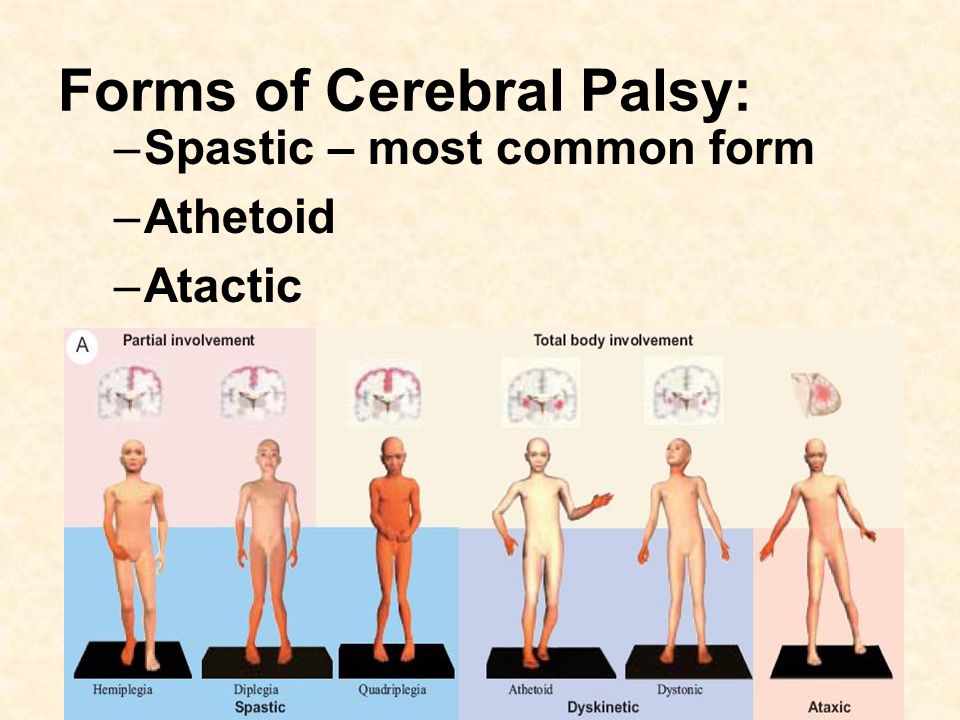
Cerebral Palsy: What It Is
Cerebral Palsy (CP) was named by William Osler, a reputable Canadian physician and one of the four founding professors of John Hopkins Hospital. It was coined from Cerebral Child-Paralysis and has since been used to describe motor (movement) disorders in children. Cerebral Palsy or CP, a neurological condition, is a group of movement disorders that affect children in early childhood mostly during pregnancy, childbirth or shortly after birth. It is a permanent abnormal development or damage to the parts of the developing brain responsible for movement, balance and posture.
Prevalence
In the United states of America Cerebral Palsy is the most commonly diagnosed childhood motor disability with around 10,000 babies born each year with it. In Africa, an estimation of about 2-10 Cerebral palsy cases in every 1000 births is recorded yearly.
Types of Cerebral Palsy
There are 4 different types of Cerebral Palsy depending on the kind of damage or abnormal development that occurred and they are usually characterized by different symptoms.
Spastic Cerebral Palsy or Spasticity: this involves some parts of the body including arms and legs and is characterized by high muscle tone resulting in tightness or stiffness of the affected muscles. Movement for someone with Spastic Cerebral palsy is stiff and jerky. It is the most common type of this neurological condition. It is further classified into 3 based on the body parts that are most affected. An example is spastic diplegia also called little’s disease which affects the lower extremities of the body. The others are Hemiplegia and Quadriplegia.
Ataxic Cerebral Palsy or Ataxia: This involves every part of the body and is characterized by poor balance and coordination. This is the least common type of cerebral palsy. The child with this type has difficulty with fine motor skills like reaching for objects, tying shoelaces, unsteady walking and so on.
Dyskinesia: also involving every part of the body, it is characterized by uncontrollable movements. It is also known as Athetoid cerebral palsy. The brain injury occurs in a part of the brain responsible for voluntary movement known as the basal ganglia. In this case the child cannot make his muscles move the way he wants them to.
Mixed Cerebral Palsy: mostly a combination of two or more of the other types of cerebral palsy.

Symptoms
Children or adults with cerebral palsy often have disabilities ranging from mild to severe depending on the type. Some of them include:
- Absence of or delayed growth milestones like rolling over, crawling, sitting up or walking.
- Stiff or weak muscles, tremors (involuntary movements)
- Walking difficulties.
- Trouble with coordination.
- Hearing, sensation, speaking and vision Impairments.
- Drooling and difficulty in swallowing
- Learning difficulties
- Seizures or Epilepsy
- Behavioral and emotional challenges
Risk Factors
Risk factors are occurrences that increase the chances of developing a disease condition. The factors that increase the risk of a child having Cerebral Palsy are
- Premature birth: a baby born before 28 weeks of pregnancy is prone to Cerebral Palsy. The earlier the birth of the baby, the higher the chances of developing CP.
- Multiple babies (twin, triplets): when more than one child is sharing the uterus, it increases the risk. The risk is further increased when one of them dies.
- Infections during pregnancy: some infections like Toxoplasmosis caused by a parasite found in contaminated food when ingested by the mother can increase the risk of her pregnant child having Cerebral Palsy. Syphilis, a sexually transmitted bacteria and Herpes which can be transferred from mother to child, affecting the womb and placenta also increases the chances to the child developing cerebral palsy. Rubella (German Measles) if found in the mother is also a risk factor.
- Difficult delivery: the risk of Cerebral Palsy is increased when there are difficulties like the baby being in the Breech position, the feet-first position instead of headfirst at the beginning of labour. Another difficulty that can occur is when the brain does not get enough oxygen during labor, although this is not a high-risk factor of Cerebral palsy.
- Head Trauma: when a newborn has an accident or has a fall that affects the brain or causes an injury to the brain, the baby is very likely to have cerebral palsy.
- Low Birth Weight: babies born at 2.5kg or below are at increased risk of having cerebral palsy. The lower the birth weight, the higher the risk.
Prevention of Cerebral Palsy
Cerebral palsy cannot outrightly be prevented but the risks of your child having it can be lowered b having ample information and being careful and cautious.
- Avoid taking harmful on unprescribed substances during pregnancy
- Get vaccinated against risk infections like rubella
- Visit your obstetrician for regular checkups during pregnancy to ward off or quickly dispel any infections and to screen you for possible complications during pregnancy
Cerebral Palsy is not curable. However, the damage is not progressive as it does not worsen overtime as the child grows into adulthood. People with this condition would naturally need support from family and friends to help them live as normally as possible depending on the type of cerebral palsy. Apart from the Medications that would be given to children diagnosed with cerebral palsy, a number of specialists are also required; Cerebral palsy does not kill, a lot of children with this condition grow up to live independently as adults depending on the severity of disabilities it causes. Some may have to live on the support and care of their family forever. However, some complications of cerebral palsy may be life threatening if not properly managed. For instance, difficulty in swallowing may cause malnutrition and is a risk factor for other deficiencies and lowered immunity against infections. Generally, when well-managed, a child with cerebral palsy can have the same life expectancy as other children.
